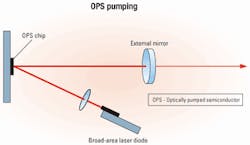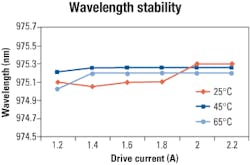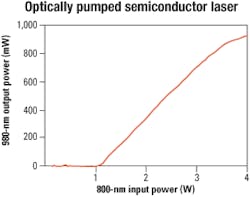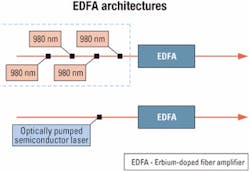High-power 980-nm pumps for high-power amplifiers
New optically pumped semiconductor lasers offer the performance and economic benefits required for high-power fiber amplifiers.
JUAN CHILLA, ED REA, MARK GITIN, and DAN NASH, Coherent Inc.
A novel semiconductor-based laser design known as an optically pumped semiconductor laser (OPSL) provides >500 mW of operating output from a singlemode fiber at a nominal wavelength of 980 nm. The OPSL is a special class of vertical-cavity surface-emitting laser (VCSEL) that is activated by a diode pump laser rather than current injection.
The OPSL offers unique capabilities, including the potential for multiwatt output power, a linear power-versus-current curve, and stable spectral output, from a compact singlemode-fiber package ideally suited for the development of telecommunications and cable TV applications.
OPSL technology
Figure 2. This Raman design uses a single pump and depolarizer at higher wavelengths.The OPSL differs from other semiconductor lasers in that it is optically pumped rather than driven electrically by current injection. Furthermore, unlike an edge-emitting-diode laser that emits an optical beam parallel to its active junction plane, an OPSL emits radiation perpendicular to the active region of the device.
An OPS chip is grown using molecular-beam epitaxy. The chip includes a high-reflectivity structure that comprises several high- and low-index layers. The structure also contains several absorbing regions designed to absorb light efficiently at a convenient pump-laser wavelength and quantum wells designed to provide optical gain at the desired output wavelength.
To optically pump the OPS, the output of an edge-emitting, high-power, multimode, broad-area, 800-nm diode laser is directed onto the chip at an offset angle (see Figure 1). Because of the broad absorption bandwidth of the OPS structure, the wavelength of the pump laser is not critical. This wavelength can be changed by ±20 nm without influencing the output of the OPSL itself. Consequently, the specifications for the optical pump can be significantly relaxed, thereby reducing manufacturing costs.
The absorption of the photons from the 800-nm diode leads to the electron-hole pair formation in the OPS chip, followed by a recombination that produces the laser emission. The laser cavity is defined by the highly reflective rear mirror of the OPS chip and an external concave mirror, which acts as the output coupler. Beam circularization optics are used in the 800-nm beam to improve efficiency and create a circular gain zone in the OPS chip.Unlike conventional edge-emitting-diode lasers, which have an elliptical output beam, the output of an OPSL is circular in cross section. A combination of the OPSL's external-cavity design and properties of the 800-nm beam create an output beam that is TEM00 with an M2 value of <1.1. This output is launched into a fiber with >90% efficiency.
The OPSL is a flexible platform that can be tailored to suit the needs of a variety of applications. One reason for this flexibility is that the OPSL chip typically emits over a broad wavelength range that has full-width-at-half-maximum of approximately 25 nm. The cavity can be designed to select a specific output wavelength according to the end user's requirements. This patented design offers the added advantage of lowering the ambient-temperature sensitivity of the OPSL by an order of magnitude below that of a conventional edge-emitting diode.1 The OPSL achieves this wavelength stability over a wide temperature range without the use of a fiber Bragg grating to stabilize the wavelength (see Figure 2).
Multiwatt output
OPSL output power levels in excess of 5 W at 980 nm have been demonstrated. OPSLs can produce these high powers because compared to standard edge-emitting diodes they have much lower power density on their semiconductor surfaces. For example, a 500-mW OPSL has a mode diameter of 150 microns at the OPS chip, or an emission area of about 7,700 square microns. That results in a power density that is three orders of magnitude lower than that of a conventional 300-mW diode-laser facet, which has an emitting area of between 3 and 10 square microns. This difference in area allows the OPSL to operate at high power while greatly reducing the risk of damage to the semiconductor. The use of active-area aluminum-free chips that minimize oxidation further reduces this risk.
The growing demand for higher-bandwidth telecommunications is driving the design of DWDM equipment. Currently deployed DWDM systems typically consist of 16-32 wavelength channels that fit under the fiber-amplifier-gain curve. Several manufacturers have demonstrated that future deployments will contain far higher channel counts and greater bandwidth.
A key requirement for the success of such developments is high-powered broadband amplification systems to effectively amplify every wavelength channel. This amplification becomes even more critical as additional features are added to the systems, such as gain-flattening, gain equalization, and dispersion compensation, which add to overall loss of the system.
As a result, amplification systems are requiring increasingly higher pump powers to meet their design targets. Current techniques used for pumping high-power erbium-doped fiber amplifiers, such as ganging multiple edge-emitting pump diodes or using multistage pumping, have several limitations, including high cost, design complexity, and difficulty of control, that make them undesirable. Until recently, no single 980-nm diode-laser device had the output power required to pump high-power fiber amplifiers. OPSL technology is a viable and inexpensive ($/mW) method of producing high-power 980-nm laser light for telecom and cable TV amplifier applications.
When considering an architecture combining multiple pump lasers (see Figure 4), there are many issues confronting a design engineer. Combining 980-nm pumps requires additional hardware such as multiplexers and isolators and the labor to assemble them. That could increase the total installed cost over the individual unit prices of the pump by up to 50%.Aside from the financial cost of these devices, there is also a cost associated with the usable power of the pumps. Each coupler in a system leads to a loss of about 0.3 dB. Consequently, depending on the number of lasers used, the total loss could approach 0.6 to 1.2 dB, thereby reducing the performance of the amplifier compared to the nominal pump power being applied.
There are also costs associated with the increased size and complexity of combining the devices. The combined lasers need to be selected to operate at slightly different wavelengths (usually at 2-nm intervals) but must still lie under the amplifier's absorption curve. Because the useful absorption curve is typically 10 nm wide, there is a limit to the number of pump lasers that can be combined and ultimately to the output power of the amplifier. The multipump configuration also increases the complexity of the amplifier's control circuitry and algorithms since there are different levels of gain produced by each of the different pump wavelengths. The additional circuitry, along with the combined footprints of the multiple devices, increases the overall size of the amplifier.
These concerns make the use of a single high-power pump source preferable. Traditional single-diode, edge-emitting technology is advancing to meet this need, but there are physical limits to what these devices can achieve. The currently available technology provides 360-mW kink-free power (325-mW operating power), with some upside growth potential. As mentioned, the OPSL technology has demonstrated significantly higher power (over 5 W) and is currently available in 500-mW operating power.
Aside from the power scalability, there are other advantages to using the OPSL technology. The spectral stability is of great use when designing wavelength-sensitive systems such as fiber amplifiers. Because the gain of a fiber amplifier is highly sensitive to changes in the pump wavelength, wavelength stability of the laser is critical.
Unfortunately, that is not always possible with conventional diode lasers. Existing 980-nm edge-emitting lasers are not true single-longitudinal-mode lasers. In fact, some chips emit a dominant line and one or more weak secondary lines. Measurable power drift over time from the primary to secondary lines can cause havoc in an amplifier. Consequently, the wavelength stability of the OPSLs makes it highly desirable as a 980-nm pump source.
The unique characteristics of the OPSL also enable the development of new system configurations and design paradigms. The availability of easily controlled, higher power allows for the exploration of new architectures, which can help exploit larger portions of the transmission spectrum.
A recent study has demonstrated the value of 980-nm OPSLs in new amplifier applications. The study, conducted by Nortel Networks, showed that a thulium-doped fiber amplifier exhibited optical gain of up to 17.3 dB in the S-band (1450-1500 nm) when pumped with a 1550-nm source in conjunction with a 500-mW, 983-nm OPSL.2
Strong combination
The search for high-power laser technology for high fiber-amplifier gain applications has led to the development of OPSLs. Unlike alternative technologies, these lasers offer the right combination of high-output singlemode power, 980-nm operating wavelength range, stable performance, and commercial availability.
The OPSL will allow high-power-fiber-amplifier architectures to be greatly simplified and manufacturing costs to be lowered, since they are more cost-effective than the combination of multiple diodes. Because the output power of the OPSL is scalable to multiwatt levels, future generations of these devices will be able to satisfy the demand for higher amplifications as the need for increased telecom bandwidth arises.
Juan Chilla and Ed Rea are senior scientists for Active Products, Mark Gitin is marketing director, and Dan Nash is the product manager for Pump Lasers in the Coherent Telecom-Actives Group, Coherent Inc. (San Jose, CA). For additional information, contact Gitin at [email protected].
References
- United States Patent 5,991,318.
- E. Zhang, S. Wilson, D. Crippa, R. DiMuro, and A. Maroney, "Tm-doped fiber amplifiers in the 1480nm region with 980nm/1550 pumps," Optical Society of America, 2000.
This article is also found on Lightwave's home page at www.lightwaveonline.com.




